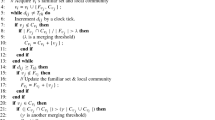Abstract
Mobile social networks are networks with mobile nodes which have social properties. Various methods for routing have been introduced in these networks. Some of these methods take advantage of single-copy message forwarding and some take advantage of multi-copy message forwarding. In single-copy forwarding, due to fragility of the route, the probability of the message delivery decreases. For example, there is possibility that the node receiving the packet becomes damaged. In the multi-copy methods, in which there is no control over the number of the message replications, the network overhead increases. In the methods recently presented a balanced state between two mentioned methods has been created which applies quota allocation in controlling the replications number of message copies in the network. It seems that employing social features in determining the number of replication licenses has an impact in the efficiency of routing methods. In this article a multi-copy routing method, named SFQ, has been introduced which controls the number of copy replications by the adjustment of the quota. The SFQ method uses social property of nodes in determining the quota of each node. In this method those nodes which have more common properties with the destination receive more quotas of replication permissions. The results of simulation by the software of ONE display that in average the ratio of message delivery in this method is more than the two other methods.






Similar content being viewed by others
References
Hu, X., Chu, T. H., Leung, V. C., Ngai, E. C. H., Kruchten, P., & Chan, H. C. (2015). A survey on mobile social networks: Applications, platforms, system architectures, and future research directions. IEEE Communications Surveys and Tutorials, 17(3), 1557–1581.
Puri, P., & Singh, M. P. (2013). A survey paper on routing in delay-tolerant networks. In 2013 International conference on information systems and computer networks (ISCON) (pp. 215–220)
Hu, X., Li, Y., & Xu, H. (2017). Multi-mode clustering model for hierarchical wireless sensor networks. Physica A: Statistical Mechanics and its Applications, 469, 665–675.
Benamar, N., Singh, K. D., Benamar, M., El Ouadghiri, D., & Bonnin, J.-M. (2014). Routing protocols in vehicular delay tolerant networks: A comprehensive survey. Computer Communications, 48, 141–158.
De Rango, F., Tropea, M., Laratta, G. B., & Marano, S. (2008). Hop-by-hop local flow control over interplanetary networks based on DTN architecture. In 2008 IEEE International Conference on Communications (pp. 1920–1924)
Hui, P., Chaintreau, A., Scott, J., Gass, R., Crowcroft, J., & Diot, C. (2005). Pocket switched networks and human mobility in conference environments. In Proceedings of the 2005 ACM SIGCOMM workshop on delay-tolerant networking (pp. 244–251).
Lo, S. C., Tsai, C. C., & Lai, Y. H. (2015). Quota-control routing in delay-tolerant networks. Ad Hoc Networks, 25(Part B), 393–405.
Vahdat, A. & Becker, D. (2000). Epidemic routing for partially connected ad hoc networks. Technical Report CS-200006, Duke University.
Lo, S.-C., Chiang, M.-H., Liou, J.-H., & Gao, J.-S. (2011). Routing and buffering strategies in delay-tolerant networks: Survey and evaluation. In 2011 40th international conference on parallel processing workshops (pp. 91–100). IEEE.
Burgess, J., Gallagher, B., Jensen, D., & Levine, B. N. (2006). MaxProp: Routing for vehicle-based disruption-tolerant networks. In INFOCOM (pp. 1–11).
Lindgren, A., Doria, A., & Schelen, O. (2004) Probabilistic routing in intermittently connected networks. In Service assurance with partial and intermittent resources (pp. 239–254). Springer, Berlin.
Hui, P., Crowcroft, J., & Yoneki, E. (2011). Bubble rap: Social-based forwarding in delay-tolerant networks. IEEE Transactions on Mobile Computing, 10, 1576–1589.
Daly, E. M., & Haahr, M. (2007). Social network analysis for routing in disconnected delay-tolerant manets. In Proceedings of the 8th ACM international symposium on Mobile ad hoc networking and computing (pp. 32–40).
Li, Q., Zhu, S., & Cao, G. (2010) Routing in socially selfish delay tolerant networks. In 2010 Proceedings IEEE INFOCOM (pp. 1–9)
Derakhshanfard, N., Sabaei, M., & Rahmani, A. M. (2015). CPTR: Conditional probability tree based routing in opportunistic networks. In Wireless networks (pp. 1–8).
Derakhshanfard, N., Sabaei, M., & Rahmani, A. M. (2015). Sharing spray and wait routing algorithm in opportunistic networks. Wireless Networks, 2, 1–12.
Spyropoulos, T., Psounis, K., & Raghavendra, C. S., (2005). Spray and wait: an efficient routing scheme for intermittently connected mobile networks. In Proceedings of the 2005 ACM SIGCOMM workshop on delay-tolerant networking (pp. 252–259).
Nelson, S. C., Bakht, M., Kravets, R., & Harris, A. F., III. (2009). Encounter: Based routing in DTNs. ACM SIGMOBILE Mobile Computing and Communications Review, 13, 56–59.
Elwhishi, A., & Ho, P.-H. (2009). SARP-a novel multi-copy routing protocol for intermittently connected mobile networks. In GLOBECOM 2009 global telecommunications conference (pp. 1–7). IEEE.
Mei, A., Morabito, G., Santi, P., & Stefa, J. (2011). Social-aware stateless forwarding in pocket switched networks. In INFOCOM, 2011 Proceedings IEEE (pp. 251–255).
Wu, J., & Wang, Y. (2014). Hypercube-based multipath social feature routing in human contact networks. IEEE Transactions on Computers, 63, 383–396.
Keränen, A., Ott, J., & Kärkkäinen, T. (2009). The ONE simulator for DTN protocol evaluation. In Proceedings of the 2nd international conference on simulation tools and techniques (p. 55).
Author information
Authors and Affiliations
Corresponding author
Additional information
Publisher's Note
Springer Nature remains neutral with regard to jurisdictional claims in published maps and institutional affiliations.
Rights and permissions
About this article
Cite this article
Tahouri Asl, S., Derakhshanfard, N. SFQ: Social Features Based Quota Routing in Mobile Social Networks. Wireless Pers Commun 104, 1109–1120 (2019). https://doi.org/10.1007/s11277-018-6070-1
Published:
Issue Date:
DOI: https://doi.org/10.1007/s11277-018-6070-1




